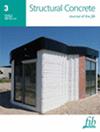钢-混凝土结构中螺栓和 SFCBs 加固 PBL 复合连接件的剪切行为
IF 3.3
3区 工程技术
Q2 CONSTRUCTION & BUILDING TECHNOLOGY
引用次数: 0
摘要
为了充分利用螺柱和 PBL 连接器的优势,我们提出了一种新型复合剪力连接器,将螺柱焊接到 PBL 剪力连接器的 H 型钢上。此外,为了进一步提高结构的耐久性能,还使用了钢纤维增强聚合物复合杆(SFCB)来替代钢筋作为贯穿钢筋。本研究通过推出试验研究了 SFCBs 增强复合材料剪切连接件的剪切行为。分析了螺柱数量、孔数量和贯穿钢筋类型对复合剪力连接件失效模式、载荷-滑移曲线和剪力行为的影响。试样的破坏模式主要是剪切螺柱和压碎混凝土。增加螺柱和孔的数量可使抗剪性能提高至少 7.47%,刚度提高 12.36%。SFCB 对抗剪性能的影响很小,并降低了刚度,但可以改善延展性,最大改善幅度为 11.49%。此外,还建立了有限元模型进行参数分析。结果表明,SFCB 和孔的直径对抗剪性能有显著影响。根据各种成分的贡献建立了一个计算抗剪能力的方程,该方程适用于复合材料抗剪连接器,具有良好的准确性和适用性。本文章由计算机程序翻译,如有差异,请以英文原文为准。
Shear behavior of stud and SFCBs‐reinforced PBL composite connectors in steel‐concrete structures
In order to fully utilize the advantages of stud and perfobond leiste (PBL) connectors, a new composite shear connector was proposed in which the studs were welded to the H‐beam of the PBL shear connectors. In addition, to further improve the durability performance of the structure, steel‐fiber‐reinforced polymer composite bars (SFCBs) were used to replace steel rebars as penetrating rebars. In this study, the shear behaviors of SFCBs‐reinforced composite shear connectors were investigated by push‐out tests. The effects of the number of studs, the number of holes, and the type of penetrating rebars on the failure mode, load–slip curve, and shear behavior of the composite shear connectors were analyzed. The specimens' failure modes were mainly shearing the studs and crushing the concrete. Increasing the number of studs and holes has resulted in an increase of at least 7.47% in the shear resistance and 12.36% in the stiffness. SFCB had little effect on the shear resistance and reduced the stiffness but could improve ductility, with a maximum improvement of 11.49%. Additionally, a finite element model was established for parametric analysis. The results showed that the diameter of the SFCB and hole had a significant impact on the shear resistance. An equation for calculating the shear resistance based on the contributions of various components has been established that was applicable to composite shear connectors and has good accuracy and applicability.
求助全文
通过发布文献求助,成功后即可免费获取论文全文。
去求助
来源期刊

Structural Concrete
CONSTRUCTION & BUILDING TECHNOLOGY-ENGINEERING, CIVIL
CiteScore
5.60
自引率
15.60%
发文量
284
审稿时长
3 months
期刊介绍:
Structural Concrete, the official journal of the fib, provides conceptual and procedural guidance in the field of concrete construction, and features peer-reviewed papers, keynote research and industry news covering all aspects of the design, construction, performance in service and demolition of concrete structures.
Main topics:
design, construction, performance in service, conservation (assessment, maintenance, strengthening) and demolition of concrete structures
research about the behaviour of concrete structures
development of design methods
fib Model Code
sustainability of concrete structures.
 求助内容:
求助内容: 应助结果提醒方式:
应助结果提醒方式:


